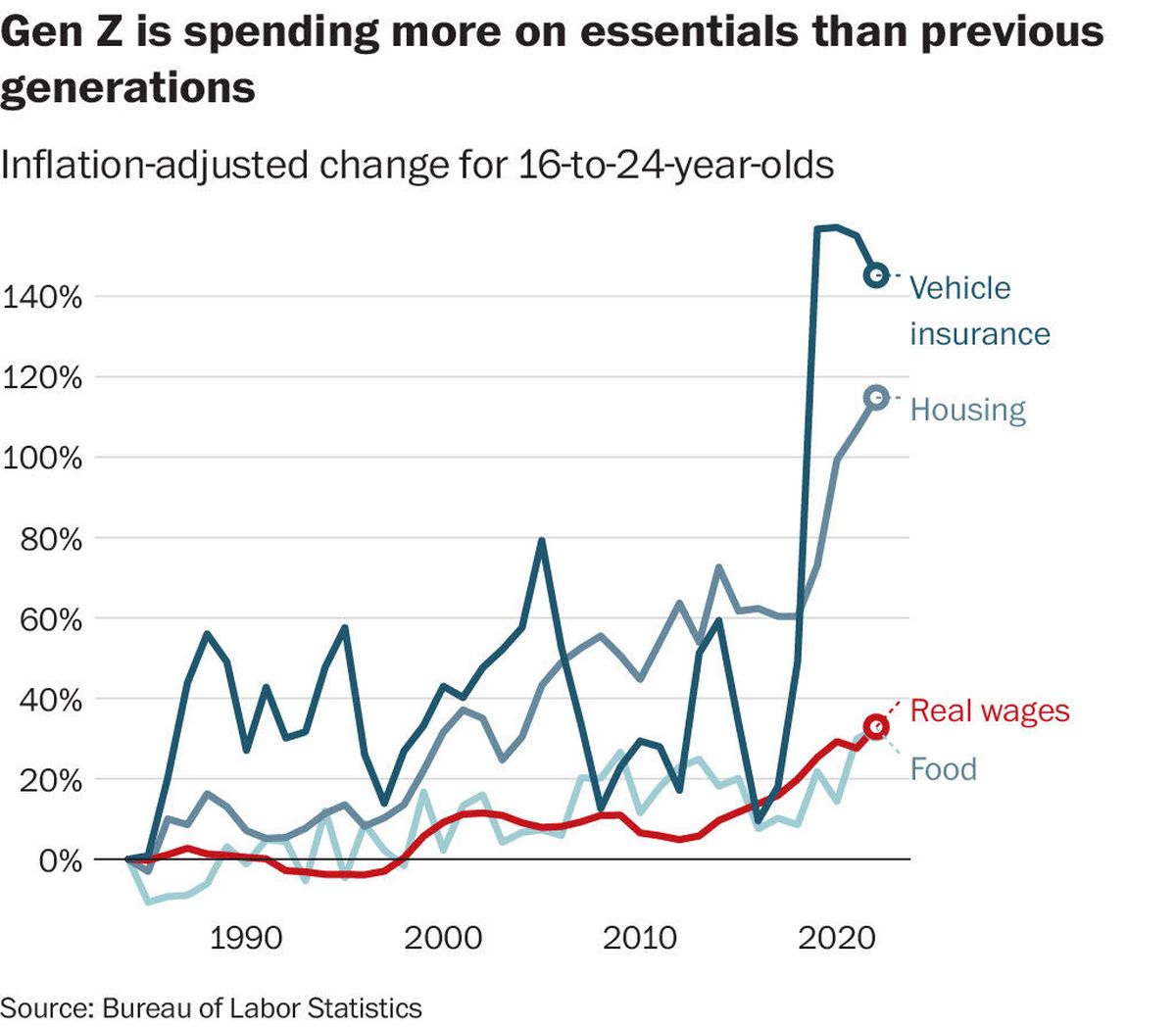Millennials had it bad financially, but Gen Z may have it worse
Generation Z real estate agents Bryan Cornejo, 21, and Khloe Hammond, 22, sell homes in the Las Vegas area. (K.M. Cannon/Las Vegas Review-Journal/TNS) (K.M. Cannon)
Move over, millennials. There’s a new generation being walloped by the economy.
Generation Z has been disproportionately pummeled by rising prices, higher housing costs, larger student loan balances and more overall debt than the millennials before them.
While both generations came of age in the midst of an economic upheaval, Gen Z is spending more on necessities than millennials did at the same age, according to a Washington Post analysis of Bureau of Labor Statistics data. While millennials are between 28 and 43, Gen Z generally refers to those ages 12 to 27.
So far, Gen Z workers are more likely to go to college, have jobs and make more money than millennials did. But they are also paying 31% more for housing than their counterparts were a decade ago, after adjusting for inflation. Spending on car insurance by people 16 to 24 more than doubled between 2012 and 2022, BLS data shows, while health insurance spending for that age group is up 46% after inflation.
By comparison, inflation-adjusted earnings for the cohort have risen much less in the same period, by 26%, federal data shows.
“Gen Z consumers have seen their finances significantly impacted by the pandemic and its aftermath, even more so than the challenges faced by millennials as a result of the global financial crisis,” said Michele Raneri, head of U.S. research at TransUnion. “Both of these cohorts have emerged from a difficult financial situation, but Gen Z is having a harder time affording this new cost of living.”
The financial difficulties burdening Gen Z could help explain President Biden’s challenges in connecting with younger voters, who cite inflation as their top concern. Just 32% of voters under 30 said in May that they would support Biden if the election were held today, giving him a two percentage point lead over Donald Trump, according to the University of Chicago’s GenForward survey.
Compared with millennials at the same age, Gen Z has more debt of all kinds - including credit cards, car loans and mortgages - after adjusting for inflation, according to TransUnion’s internal records. Today’s 22-to-24-year-olds are also more likely to be delinquent on credit cards and car loans than the generation before them, the credit reporting agency found.
And debt loads have gone up faster than rising incomes for Gen Z, TransUnion found. Debt was equivalent to about 16% of Gen Z’s income at the end of last year, compared with 12% for millennials a decade earlier.
Sarah Martin, a 21-year-old in Pittsburgh, started accumulating credit card debt a couple of years ago with impulse buys like clothing and makeup, after pandemic restrictions finally lifted. Things spiraled out of control with some emergency dental work, leading her to max out one credit card and come close to topping out another. In all, Martin racked up about $8,000 in debt, which she is still working on paying down.
Her financial challenges, she said, feel inescapable. Martin was in elementary school during the Great Recession, when both her parents lost their jobs and then their home. Now she’s facing many of the same financial hurdles early in adulthood, leaving her nervous about the future.
“I grew up in a lot of financial turmoil and it just feels like it’s kept going,” said Martin, who is living with her parents while she studies to be a medical coder. “The high interest rates have definitely made it feel like I’m constantly running toward paying off my debt, but it’s just never going to happen.”
Roughly 1 in 7 Gen Zers are maxed out on their credit cards, more than any other generation, according to the New York Fed. The ripple effects of that debt are also far higher than in the past, with average credit card interest rates at an all-time high, nearing 22%.
“Even if you adjust for inflation, these credit card balances (among Americans in their early 20s) have gone up by about 25%. Delinquencies are higher among young adults now than they have been in the past,” said Ted Rossman, a credit card analyst at Bankrate. “To be just starting out and already falling behind the eight ball can be a tough cycle to break.”
Economists say timing is also important: The pandemic forced Gen Z to hunker down at home in their prime high school and college years, when they would otherwise have been out with friends, going to concerts or traveling. Many were eager to make up for lost time when the world reopened in 2021.
That’s also when banks began loosening their rules on exactly who could qualify for a credit card, offering easy access to the youngest borrowers.
Thomas Black got his first credit card when he turned 18 in 2021 - and immediately maxed it out. He spent about $1,000 on gas and Christmas gifts, then racked up another few thousand dollars in debt when his car broke down.
“I spent the first three years of my adult life trying to pay that off,” said Black, who works for a security company in Akron, Ohio. “I signed up for every overtime shift I could, working 84-hour weeks, just to clear things up.”
Gen Z is coming of age at a very different time from millennials, whose early days in the workforce coincided with two recessions. Many struggled to get jobs, particularly following the Great Recession, when the nation’s unemployment rate hovered around 10% for over a year. Their wages took a massive hit, too. On average, millennials lost about 13% of their earnings between 2007 and 2017, according to economist Kevin Rinz.
By contrast, the recovery since the pandemic has been swift and broad. Unemployment was under 4% for the longest stretch in 50 years until May, and younger workers in particular have seen some of the largest pay hikes. Wages for 16-to-24-year-olds have risen 8.6% in the past year, compared with an overall gain of 5.2%, according to the Atlanta Fed.
Still, rising prices are dealing an outsize blow to Gen Z. Compared with other age groups, adults under 27 devote more of their spending to basics like housing, dining out, gas and car insurance - all of which have gotten far pricier in recent years, data from Moody’s shows.
“We’re at an inflection point: (Gen Z is) coming to age in a time of rising inflation and rising interest rates - and that will stay with them,” said Jimmie Lenz, a financial economics professor at Duke University whose work focuses on generational behavior. “There’s the immediate impact: higher monthly payments on your credit card. But there are also going to be long-term impacts, like it’s going to be harder to buy a home.”
Housing costs, which have risen rapidly since the pandemic, are by far the biggest burden on Gen Z. Adults under 35 are more likely to rent than to own and tend to move more often - both of which can result in more frequent price increases.
In all, Gen Zers are expected to spend an average $145,000 on rent by the time they turn 30, compared with the $126,000 spent by millennials at the same age, after inflation, according to an analysis of census data by RentCafe. Renting in major coastal hubs such as the San Francisco Bay Area, Boston and Honolulu has become particularly pricier for today’s young adults.
In Birmingham, Alabama, rent on the apartment Edward Wyckoff, 25, shares with his mother has jumped from $900 to $1,300 in the past few years, a 44% increase.
Wyckoff was a college sophomore when the pandemic began. He put his studies on hold, in part so he could help out with household expenses, but says it has become ever more daunting to complete his degree. He already has $18,500 in student loans and frets about taking on more debt.
“It’s ingrained in me that debt is a trap,” he said. “It seems like everyone I know is drowning in debt.”
Wyckoff is hoping to return to school. He has worked a series of jobs to save up - driving a shaved-ice truck and working as an assistant at a law firm - and is applying for scholarships and grants to ease the financial burden.
“Everything costs so much more that I’ve had to work more than I thought,” he said. “I thought I could get away with doing both school and work; I’ve had to choose work. It feels kind of like a dead end, especially with the student loans I already have.”
Members of Gen Z are not only more likely to have student loans, but they also have higher debt balances than millennials did, according to the St. Louis Fed. As of June 2022, borrowers ages 20 to 25 had average student debt of about $21,000, 13% more than millennials at the same age, after adjusting for inflation.
It is also the first generation where recent college grads are more likely to be unemployed than the general population. In a sharp reversal from long-held norms, recent college graduates have been having a harder time finding work than the rest of the population, according to the New York Fed.
Spencer Kammerman graduated from the University of California at Irvine with a degree in computer science and engineering three years ago. Since then, the 25-year-old has worked at two tech companies - and has been laid off from both.
His latest bout of unemployment began eight months ago. He’s applied to hundreds of positions and made it to the final stages several times, including at SpaceX and a government drone contractor, before losing out to other candidates.
Kammerman, who exhausted his unemployment checks a few months ago, recently moved back in with his parents in Orange County.
“It feels like the odds are stacked against us,” he said. “It’s been difficult to get off the ground. But I’m not giving up.”
- - -
Andrew Van Dam contributed to this report.
- - -
Graphics:
https://washingtonpost.com/documents/111952dd-4ab3-463b-aa8c-90015759251a.pdf
https://washingtonpost.com/documents/5041f76d-b70a-4318-ab2e-f61801e65435.pdf
https://washingtonpost.com/documents/a693136d-bbe1-4687-b0c7-f89870cfecfd.pdf
https://washingtonpost.com/documents/51ef5503-7a8e-4431-b6e3-28f8c8f462bf.pdf
https://washingtonpost.com/documents/f4a60593-df05-40f8-862f-ae847f26d527.pdf

